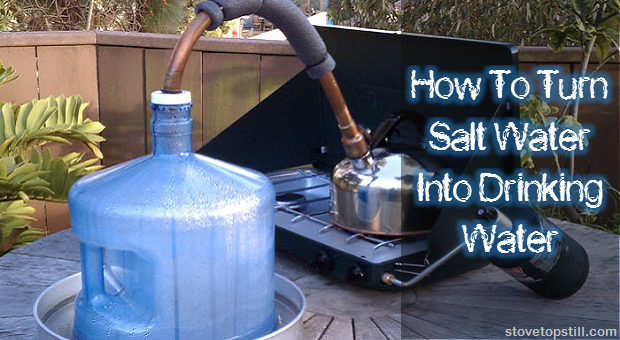One of the biggest issues for many people if SHTF is going to be finding and maintaining a consistent, safe water supply. Though our planet is covered in water, only one half of 1 percent is drinkable! For example, people who live in coastal regions are surrounded by water but it does them no good because one of the quickest ways to die of dehydration is to drink salt water.
There are ways to make that water potable, though, and science is finding even more ways. In order to turn salt water into drinking water, you need to desalinate it first. That just means that you need to remove the salt. There are many methods for doing this but the most efficient and realistic way to do it at home in a survival situation is by using the distillation by evaporation method.
How To Turn Salt Water Into Drinking Water
Distillation by Evaporation
The water will evaporate but the salt and other impurities won’t. The problem here is that it requires a ridiculous amount of energy in the form of heat to get the job done. Still, it’s effective and if you combine the process with others, such as cooking or heating, you won’t be wasting nearly so much fuel.
Evaporation Distillation Method 1
This is a simple method but won’t net much fresh water at a time. If you’re on the run or just need enough for a couple of people, it will work, though. You’ll need a metal cup heavy enough not to float or heat-resistant glass, a pot with a domed lid and heat.
- Place the cup in the pot.
- Add salt water to the pot, making sure that it doesn’t get in the cup. Don’t fill it so high that you run the risk of the water boiling into the cup.
- Turn the lid upside down and place it on the pot. Make sure that your cup is underneath the lowest point of the lid and that the lid seals well. Otherwise, you’ll lose most of your steam before it drips into the cup as fresh water.
- Turn the heat up under the pot so that the water boils gently. You don’t want it to boil so hard that it splashes salt water into the glass or upsets the glass.
- As the water boils, it will turn to steam, which will rise to the lid and run down the lid into the cup, leaving salt and other impurities in the bottom of the pan.
As a side note, you can do this with a pressure cooker too, and it will require less heat. Just be sure that you don’t boil it dry and crack the cup or the pot.
Hint: You can perform this method for turning salt water into drinking water using solar heat, too. It will take several hours so be sure that you have plenty of time and sunlight. Just put the pan out in the morning so that it has all day to evaporate. You could even substitute plastic wrap for the lid and just put a small rock or something in the center over the glass to form a drip point. If you use a round, see-through glass bottle or jug, the process will be much quicker because the glass will act as a prism, heating the water faster.
Evaporation Distillation Method 2
This method for turning salt water into drinking water allows you to distill a bit more water though you’ll still be using quite a bit of energy. It operates on basically the same theory as an alcohol still. You’ll also need a heat-resistant glass or metal bottle, a cork or rubber seal for the bottle, a few of feet of tubing and a catch-basin.
-
- Make a hole in the piece of rubber or cork just big enough for the tubing to fit in.
- Fill the bottle with water, leaving some space at the top.
- Place the tube through the cork or seal so that it is even with the bottom of the cork, then put the cork in the top of the bottle.
- Run the tubing to another container that is lower than the bottle so that the water can run out of it and not back into the bottle.
- Put the bottle over your heat source, being careful not to get the tubing hot.
- Bring the water to a boil and watch as the steam comes out of the water, through the tubing and converts back to water as it drips out of the end of the tube into your container.
Just a hint: If you have a teapot, you could attach the tubing to the spout. Same theory!
Video first seen on Black Scout Survival
Evaporation Distillation Method 3
This method is sort of a morphing of the two processes we’ve already discussed and may come in handy if you’re on the run and don’t have access to anything other than your camp pan. We always include aluminum foil in the list of things to keep in your bug-out bag and this is yet another use for it. You’ll need tubing too, so toss a few feet of it into your bag as well.
- Fill your camp pot about half way with salt water.
- Form a cone with your aluminum foil so that the tubing is wrapped around the top of the cone and the bottom is used to seal the pot.
- Place the pot over heat and run the tubing to a catch basin or bottle.
- As the water comes to a simmer, it will start to evaporate and the steam will come up through the tube, dripping fresh water out the other end.
If you have the cash, you can invest in a solar-powered desalination unit that turns salt water into drinking water so you’ll be ready when SHTF. For that matter, with a little bit of ingenuity, you can build your own. It’s just basically a larger version of the bowl-and-plastic desalination method that we just described.
You can also use reverse osmosis to desalinate water but it’s not exactly something that you can build. You can buy personal RO devices for your home and even for water bottles but building your own in a SHTF situation isn’t realistic for most people. It requires special membranes and pressurization.
There is a technology being researched right now called electro-dialysis. It’s not really new but progress has been slow on it. It involves using an electrical charge to remove the salt ions from the water and though it’s a great idea, they’ve only been able to reach about 25% desalinization. 99% is required for water to be considered potable. We’ll keep you posted on it though.
Along with desalinating water, all of the methods that we’ve described today also distill the water, effectively removing bacteria, viruses and other impurities from the water. If you’re using any of the solar methods, be sure to filter the water before you try to desalinate it because the process works best when the water is clear. Murky water will still work but it will take much longer.
If you have any other great ideas about how to turn salt water into drinking water, we’d love to hear about them in the comments section below!
This article has been written by Theresa Crouse for Survivopedia.
Here’s just a glimpse of what you’ll find in The Lost Ways:
Table Of Contents:
Making Your Own Beverages: Beer to Stronger Stuff
Ginger Beer: Making Soda the Old Fashioned Way
How North American Indians and Early Pioneers Made Pemmican
Spycraft: Military Correspondence During The 1700’s to 1900’s
Wild West Guns for SHTF and a Guide to Rolling Your Own Ammo
How Our Forefathers Built Their Sawmills, Grain Mills,and Stamping Mills
How Our Ancestors Made Herbal Poultice to Heal Their Wounds
What Our Ancestors Were Foraging For? or How to Wildcraft Your Table
How Our Ancestors Navigated Without Using a GPS System
How Our Forefathers Made Knives
How Our Forefathers Made Snow shoes for Survival
How North California Native Americans Built Their Semi-subterranean Roundhouses
Our Ancestors’Guide to Root Cellars
Good Old Fashioned Cooking on an Open Flame
Learning from Our Ancestors How to Preserve Water
Learning from Our Ancestors How to Take Care of Our Hygiene When There Isn’t Anything to Buy
How and Why I Prefer to Make Soap with Modern Ingredients
Temporarily Installing a Wood-Burning Stove during Emergencies
Making Traditional and Survival Bark Bread…….
Trapping in Winter for Beaver and Muskrat Just like Our Forefathers Did
How to Make a Smokehouse and Smoke Fish
Survival Lessons From The Donner Party
Get your paperback copy HERE
CHECK OUR survival and prepping solutions
If you found this article useful, please like our Facebook page and stay up to date with the latest articles.
WHAT TO READ NEXT:
HOW TO MAKE YOUR OWN BACON (STEP BY STEP GUIDE)
A RETURN TO THE OLD PATHS: HOW TO MAKE PEMMICAN LIKE THE NATIVE AMERICANS
20 LOST RECIPES FROM THE PIONEERS: WHAT THEY COOKED ON THEIR JOURNEY WESTWARD
SEVEN CLASSIC GREAT DEPRESSION ERA RECIPES GRANDMA USED TO MAKE
POTTED MEAT: A LOST SKILL OF LONG TERM MEAT STORAGE
BACK TO BASICS: HOW TO MAKE AND PRESERVE LARD
THE BEST WAY TO STOCKPILE VEGETABLES OFF-GRID
OLD FASHIONED PRESERVING-GRANDPA’S RECIPE FOR CURED SMOKED HAM
HOW TO MAKE GUNPOWDER THE OLD FASHIONED WAY
SURVIVAL HERBAL RECIPES FROM OUR ANCESTORS
HOW TO PRESERVE MEAT FOR SURVIVAL LIKE OUR GRANDFATHERS
OTHER USEFUL RESOURCES:
The 3 Pioneer Survival Lessons We Should Learn
The Most Effective Home Defense Strategies
Old School Hacks for Off-Grid Living
The Medical Emergency Crash Course
The Smart, Easy Way to Food Independence
How to Survive the Coming 100 Years Long Drought


